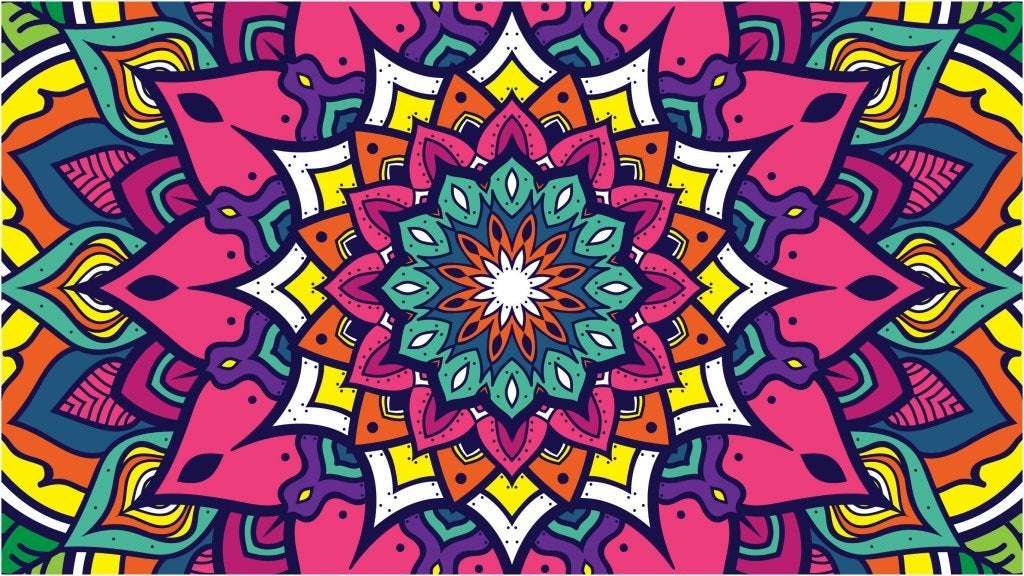We look at photographs of our family to reminisce and bring comfort. We enjoy photographs of friends for laughs or look at images of others in an unfortunate predicament to remind us that our own lives might not be that bad after all.
Imagery is a form of meditation, and meditation is a great tool for healing, restoring and enlightening our bodies.
When I received the book “The Art of Mandala Meditation,” by Michal Beaucaire (F+W media), it was the striking images that begged for my attention. The various hand-drawn, brightly illustrated mandalas, by artist Paul Heussenstamm, were comforting, energizing and relaxing without me having to do much more than scan the pages.
Mandalas, meaning “circles” in Sanskrit, are sacred symbols that are used for meditation, prayer, healing and art therapy for both adults and children. Mandalas have been shown in clinical studies to boost the immune system, reduce stress and pain, lower blood pressure, promote sleep and ease depression.
More Information
For more healthy stories and tips check out Carin Lane’s blog at http:blog.timesunion.com/healthylife
After interviewing Beaucaire via email, I realized just how much more beneficial meditation can be when guided imagery, such as these mandalas, is incorporated.
“We logically think and analyze using our brain’s left side, while the brain’s right side processes imagining, associations and connections to feelings — the hemisphere,” says Beaucaire. When we are “in harmony” we can take our mind and bodies to a whole new enlightened state capable of making ourselves feel better, stronger and more connected to ourselves, each other and our surroundings, he adds.
Q: What is it about mandalas and meditation that help our bodies?
A: It creates a different state of mind and allows us to elevate quickly into Alpha waves. At Alpha wave point, it’s easier to learn new materials, change old habits. In other words, it’s an ideal state of mind to change situations involving our body.
When we practice meditation we actually teach our mind and body a new consciousness. For example, in curing diabetes we have to teach our body to re-activate the pancreas (which is responsible for releasing the right amount of insulin to the body). If we practice anything new while gazing at a mandala, we see immediate results.
Q: How should one begin using your book? How do we choose the right meditations, and how often do we practice the meditations?
A: Readers can familiarize themselves with the book by selecting meditations they feel may improve areas in their life, or are interested in getting to know. Practitioners can then choose three meditations from their list to cure more urgent obstacles. This is a workshop book — readers should keep it close to their bed or in their leaving rooms, with the goal to review it once a month to see if priorities need to be rearranged.
Usually, meditation is captured as something we should do when we retire and have lots of time on our hands. But that’s not so. It is simply teaching the brain to do other things, unnatural thinking, by giving simple, new orders to our masterpiece called (the) body, and by doing that we connect to the essence of healing within us.
The main meditation — the one readers select to practice from the book when healing — should be used at least once a day.
Q: Before I read a single passage, I flipped through the book just admiring the beautiful circle artwork and bright colors. The book has a very calming and peaceful feeling about it, without even getting into the meditation. How did the artwork for each meditation come about? Do the colors and symbols for each one hold a special meaning unique to the meditation?
A: Once the artist Paul Heussenstamm agreed to share his artwork in my book, I chose from his website (which presents more than 2,000 different mandalas) the right mandala with the right colors and shapes for each meditation. The colors of each mandala bear the right energetic frequency of the meditation, like in color healing and chakra colors.
For example, all inner strength meditations are in yellow or have yellow in them, like the weight loss meditation, or passing an exam, confidence and self-esteem meditation and so on. Yellow is the color of the Solar Plexus Chakra, and the essence of “I” is connected to this chakra.
Q: Can you discuss some of the mental, physical and spiritual benefits this book can provide those allowing themselves to be immersed into the meditations.
A: My main goal is to inspire people to meditate on a daily basis. Given its user-friendly approach, I hope readers will feel inspired and encouraged enough to at least try meditating once.
Q: How do you know you are using the book correctly? How often and for how long should we meditate with the book?
A: We reach meditation and alpha waves more often than we realize (while running, walking, fishing, dancing, etc.), only it is hard for us to capture and understand the moment it happens. There is no right or wrong in meditating, and the reader can’t, no matter what, use this book the wrong way. In fact, all ways are correct — even if the practitioner chooses to only gaze at the mandalas without meditating.
Q: You reference in the book that by looking at the mandalas and even by just drawing or coloring your own (there are a few line drawn Mandalas in the back for coloring), it can be like art therapy. How do you suggest incorporating these pages?
A: Coloring mandalas is type of a therapy. I recently published a coloring mandala book entitled “My Mandala” and combined it with guided imagery. It’s a very powerful combination. [Users} can actually color their fears away or color their inner strength.
I suggest coloring in the blank mandalas located at book’s end directly after practicing a meditation. It brings out the artist within because coloring mandalas is not like drawing a portrait — one does not need any unique qualifications — it’s possible for everyone.
Q: The “Meditations for the Body” chapter — such as for migraines, fatigue, a cold or even for a deep sleep — is intriguing, in that it can be used as such a healing tool. How do you suggest someone use this chapter to heal themselves, but also know when it might be something to see the doctor about? Also, I noticed that the mandala for constipation is very different from the rest.
A: I believe you should always go to the doctor once you feel something is wrong; it’s irresponsible to see this book as a substitute. But if you can’t sleep and the doctor’s solution for you is pills, you might as well try the right meditation from the book first.
The healing chapter works beautifully. It’s energies we’re working with here, and not some medicine the doctor gave us. This means we need to seek results patiently on this route.
The mandala of constipation is different because it’s actually the center of a sunflower Paul painted, enlarged by the computer. …
Q: I truly enjoyed the “Meditations for the Soul” chapter. It seems like the section that would/could be used almost daily. Could you even use this in advance of a special event, interview, etc?
A: The whole idea is that meditating will be a part of your daily routine, that it will be a part of you, that you will be able to practice it while cooking, taking a walk, and so on. And once a day, before you go to sleep, practice a longer meditation. Enjoy it. Relax with it, sleep better, and wake up as good as new the next morning.
Preparing for an exam with the right meditation will give you higher marks. This meditation was tested in classes here in Israel, and it’s proven to work!
Q: The book ends with zodiac-based meditations. Would this be the one that everyone should do on a daily basis to keep in tune with themselves, the universe and our surroundings?
A: The zodiac meditations are for practicing once a year on readers’ birthdays. These meditations are designed to help practitioners get better acquainted with themselves, as they are the essence of their inner change. A true inner change can last a year, but readers can see small changes along the way if they practice all of the other meditations contained within “The Art of Mandala” meditation. We practice our zodiac mandala meditation once a year, in order to charge our intentions with the power of our birthday (which is a very unique day), and hope for a different and better year to come.
[email protected] • 518-454-5436 • @tiredorinspired
Some cultures even believe that mandalas are linked to our life energy. For example, in Eastern cultures, people believe that each color goes with a certain chakra. Chakras are energy forces linked to our bodies and our environments, and they help with our well-being. That’s why mandalas are so good for your well-being, because they have chakras in them. In the end, they’re a mythical technique that can bring you a lot of different benefits.
“ A mandala is the psychological expression of the totality of the self.”
-Carl Jung-
Mandalas bring along a feeling of relaxation
Designing and coloring mandalas can help you focus your attention. That’s why they’re a great exercise for calming down when you’re stressed and waking up your mind. Here are some benefits of mandalas:
- They help with balance.
- They bring peace and tranquility.
- Looking at them will give you a feeling of calmness.
- They help with concentration.
- They make it easier to be mindful.
- Another thing thing they do is push aside thoughts and let your creativity flow.
- The way all the shapes and designs are laid out brings a feeling of balance.


Mandalas are designed to help you become free from your worries. This is because they make it easier to focus on the present moment. It’s also why they’re such a powerful relaxation tool.
Deep connection
Mandalas make it easier to connect with the most intimate parts of yourself. That will help guide you along the path of self-knowledge. They’re an amazing tool for thinking about your place in the world, and your relationship to other people.
These artistic figures help you interweave yourself with the strongest energies within you and the universe. They do it by using all the energies that flow out of each shape and color.
Mandalas are also a kind of meditation that can help you focus your attention. They bring harmony, because energies flow through all their shapes and colors. These energies can transform negative things into positive ones, and bring balance to your life.
You should also remember that mandalas go from the center and outwards. This is what will help you connect with yourself, free yourself, rebuild yourself, and create a relationship with yourself. All this happens thanks to the different colors and shapes you choose for the mandala.


Creativity and mandalas
Mandalas are an artistic kind of free expression. In other words, you can draw them however you like. Of course if you don’t want to make the shapes themselves, you can buy books and journals and focus on coloring them in. As you can see, there are lots of options.
One interesting thing about mandalas is their strong link to creativity. They let you have absolute freedom with the colors and shapes. In other words, they make it easier to be creative, and are a great source of new ideas. On top of that, every shape and color symbolizes unconscious aspects about you. Here are some of their meanings:
- Red. Passion, sensuality, strength, power, and aggressiveness. The first chakra.
- Orange. Pleasure, glory, vanity, progress, and energy. The second chakra.
- Yellow. Happiness, willpower, and newness. The third chakra.
- Green. Hope, ease, and naturalness. The fourth chakra.
- Blue. Calmness, seriousness, respect, and communication. The fifth chakra.
- Purple. Meditation, creativity, and oscillation. The sixth chakra.
- White. Peace, harmony, goodness, delicacy, and shyness. The seventh chakra.
- Black. Depth, mystery, authority, dignity, security, sadness, and mourning.
- Circles. Dynamism and connection with the cosmos.
- Crosses. Conscious and unconscious, a merger of heaven and earth.
- Triangles. Transformation and vitality.
- Squares. Stability and balance.
- Mazes. Looking for your personal center.
“Flow with whatever may happen, and let your mind be free: Stay centered by accepting whatever you are doing. This is the ultimate.”
-Chuang Tzu-
Mandalas as decoration
You can also use mandalas to decorate your house or your workplace. Here are some ideas for using them as decorations:
- Paint mandalas on rocks and use them as ornaments.
- Sew a mandala and use it as a blanket.
- Put a mandala tapestry on your wall.
- Put them in decorative frames.


Therapeutic benefits of mandalas
Mandalas have been recognized by psychology as a therapeutic tool. The Swiss psychologist Carl Jung said they’re like representations of our mind. He thought they made it easier for us to concentrate on, transform, and internalize unconscious things in us. He also said that we project what we think and feel into mandalas.
There are also multiple different branches of psychology that have talked about their benefits. Transpersonal psychology sees mandalas as a kind of exercise for deep connection. Cognitive and behavioral psychology see it as a tool to improve things like memory, attention, perception, and visuomotor coordination.
There are some other settings where people use mandalas, too. For example, people use them in occupational therapy because the cognitive stimulation helps people do their daily activities. People also use them in educational settings to help students with concentration, attention, and discipline.
As you can see, there are lots of benefits you can get from mandalas. They’re like pieces of art that can help you relax and free your mind. They also have huge creative potential. So why don’t you give them a try?
“Everything that shows up in your mandala is a vehicle for your awakening. From this point of view awakening is right at your fingertips continually.”
-Pema Chödrön-
It might interest you…



